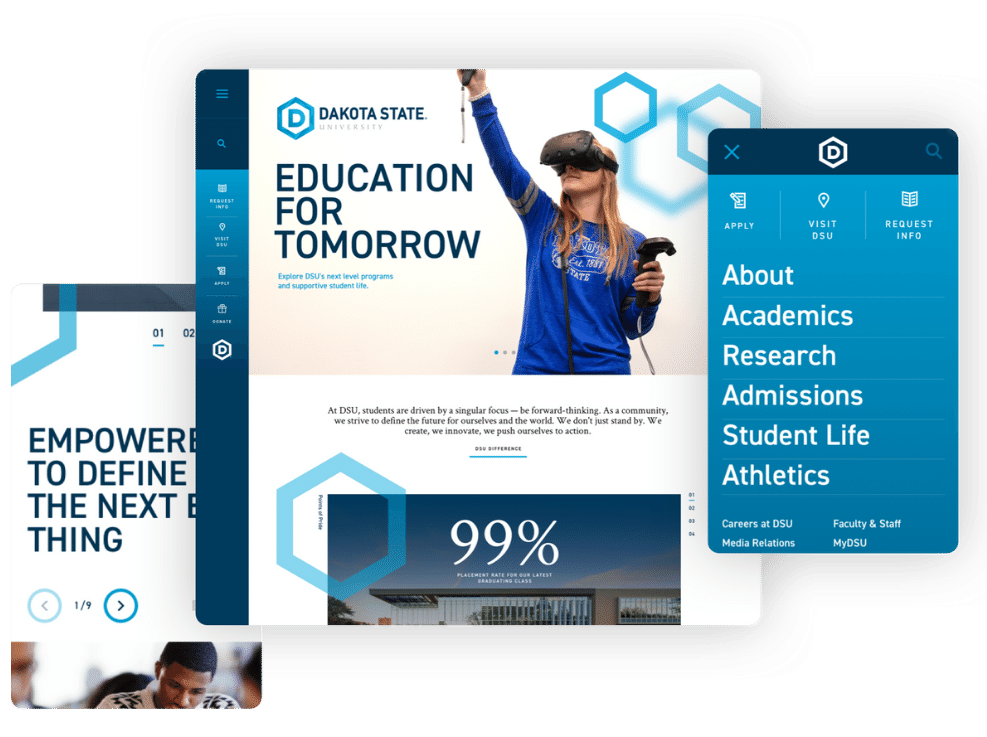Transforming Your Online Existence with Advanced Web Design Solutions
A Thorough Review of the most effective Practices in Website Design for Developing User-friendly and Accessible Online Systems
The performance of an online platform hinges substantially on its design, which have to not just bring in individuals yet likewise lead them flawlessly via their experience. Understanding these principles is vital for designers and programmers alike, as they straight effect customer satisfaction and retention.
Understanding Individual Experience
Recognizing customer experience (UX) is essential in internet design, as it straight affects how visitors engage with a web site. A properly designed UX makes certain that customers can navigate a website without effort, gain access to the info they look for, and full desired activities, such as signing or making a purchase up for a newsletter.
Crucial element of efficient UX style include functionality, availability, and aesthetic appeals. Functionality focuses on the simplicity with which individuals can achieve tasks on the website. This can be attained through clear navigating structures, rational material company, and responsive feedback systems. Availability makes certain that all customers, including those with specials needs, can interact with the website successfully. This entails adhering to established guidelines, such as the Internet Content Availability Standards (WCAG)
Looks play a crucial role in UX, as aesthetically appealing layouts can improve customer fulfillment and involvement. Color design, typography, and images needs to be attentively selected to produce a natural brand identity while likewise helping with readability and understanding.
Inevitably, focusing on customer experience in web style cultivates greater individual complete satisfaction, encourages repeat check outs, and can substantially boost conversion rates, making it an essential facet of effective digital methods.
Value of Responsive Style
Responsive style is a critical component of modern web advancement, guaranteeing that websites provide an ideal watching experience throughout a vast variety of tools, from desktops to mobile phones. As user actions progressively shifts in the direction of mobile surfing, the demand for internet sites to adjust flawlessly to different display sizes has ended up being critical - web design. This versatility not only boosts usability however also substantially effects individual involvement and retention
A responsive style employs fluid grids, versatile photos, and media inquiries, permitting for a cohesive experience that maintains functionality and aesthetic integrity regardless of tool. This method eliminates the demand for customers to focus or scroll horizontally, causing a more instinctive interaction with the content.
Additionally, online search engine, significantly Google, focus on mobile-friendly sites in their positions, making receptive layout essential for keeping presence and access. By taking on receptive design concepts, companies can reach a broader audience and improve conversion prices, as users are most likely to engage with a site that supplies a smooth and consistent experience. Ultimately, responsive style is not just an aesthetic option; it is a calculated requirement that shows a dedication to user-centered layout in today's digital landscape.
Simplifying Navigation Frameworks

Making use of a hierarchical framework can dramatically enhance navigating; main categories must be easily available, while subcategories need to practically comply with. Consideration of a "three-click guideline," where individuals can get to any kind of page within 3 clicks, is helpful in maintaining navigation intuitive.
Incorporating a search attribute even more enhances functionality, enabling customers to find content directly. web design. In addition, carrying out breadcrumb routes can provide individuals with context concerning their location within the website, advertising simplicity of navigating
Mobile optimization is another crucial facet; navigating must be touch-friendly, with plainly specified links and switches to suit smaller sized displays. By lessening the variety of clicks required to accessibility material and ensuring that navigating is constant throughout all web pages, developers can develop a seamless individual experience that encourages expedition and decreases irritation.
Prioritizing Availability Requirements
About 15% of the worldwide population experiences some type of impairment, making it crucial for web designers to focus on availability requirements in their tasks. Availability incorporates various elements, including aesthetic, auditory, cognitive, and motor disabilities. By adhering to established standards, such as the Web Material Accessibility Guidelines (WCAG), designers can produce comprehensive electronic experiences that accommodate all individuals.
One fundamental method is to make certain that all web content is perceivable. This consists of offering different text for photos and ensuring that video clips have captions or transcripts. Key-board navigability is crucial, as several customers count on keyboard shortcuts instead than computer mouse communications.
Additionally, shade contrast must be thoroughly thought about to accommodate people with visual impairments, making sure that text is readable versus its background. When designing types, tags and error messages must be detailed and clear to aid users in completing jobs efficiently.
Lastly, performing use screening with individuals who have handicaps can offer vital insights. By prioritizing availability, internet developers not only follow lawful criteria however also broaden their target market reach, fostering a much more inclusive online environment. This dedication to access is crucial for a easy to use and absolutely accessible web experience.
Utilizing Aesthetic Pecking Order
Clarity in design is extremely important, and making use of visual power structure plays a critical function in attaining it. Visual hierarchy describes the setup and presentation of components in a manner that clearly suggests click to read more their relevance and view website guides user attention. By tactically using size, contrast, spacing, and shade, developers can develop an all-natural circulation that routes customers via the web content perfectly.
Using bigger fonts for headings and smaller ones for body message develops a clear distinction between sections. In addition, using strong colors or contrasting backgrounds can accentuate critical details, such as call-to-action buttons. White area is similarly vital; it aids to stay clear of mess and permits customers to concentrate on the most important elements, enhancing readability and total user experience.
An additional trick aspect of visual pecking order is the use of imagery. Pertinent images can boost understanding and retention of information while likewise separating text to make content a lot more digestible. Ultimately, a well-executed aesthetic hierarchy not just boosts navigation yet likewise promotes an user-friendly communication with the web site, making it more likely for individuals to accomplish their purposes successfully.

Conclusion
In summary, adherence to ideal techniques in website design is essential for developing instinctive and navigable on the internet platforms. Stressing responsive design, simplified navigation, and access standards fosters a inclusive and user-friendly setting. web design. Furthermore, the effective use aesthetic hierarchy boosts individual involvement and readability. By focusing on these components, internet designers can significantly improve customer experience, making sure that on the internet platforms meet the diverse demands of all individuals while promoting effective communication and fulfillment.
The performance of an online platform browse around here pivots substantially on its layout, which should not just attract customers however additionally guide them perfectly through their experience. By adopting receptive design concepts, services can reach a wider target market and boost conversion prices, as customers are extra most likely to involve with a site that supplies a smooth and consistent experience. By adhering to established standards, such as the Internet Web Content Access Standards (WCAG), designers can produce inclusive digital experiences that provide to all customers.
White area is similarly crucial; it aids to avoid mess and permits users to focus on the most essential elements, improving readability and overall individual experience.
By focusing on these aspects, web designers can dramatically boost user experience, guaranteeing that on the internet platforms fulfill the varied requirements of all users while helping with effective interaction and fulfillment.